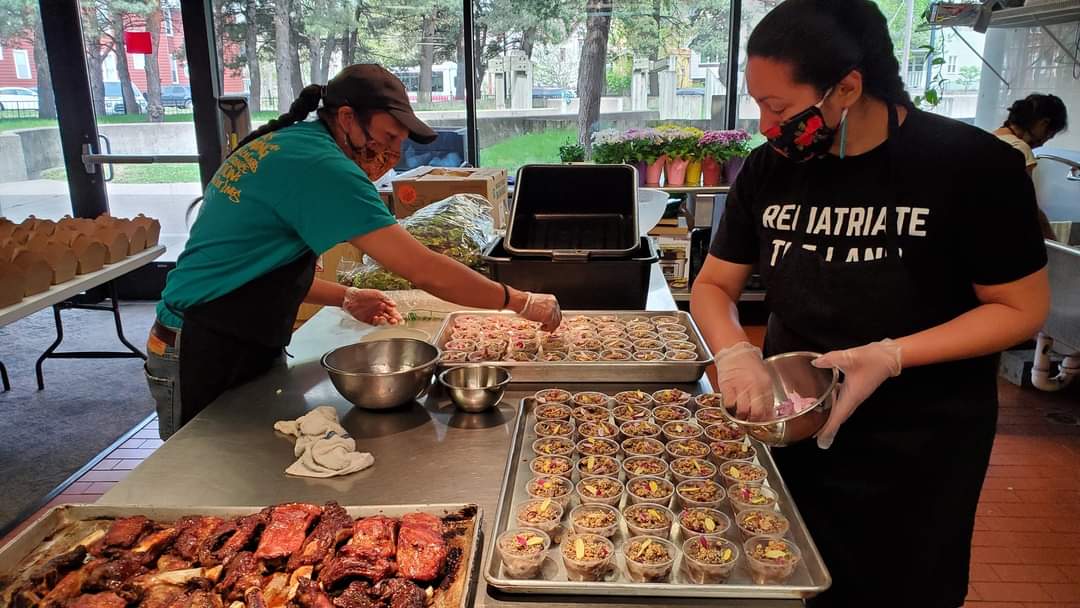
- Details
- By Valerie Vande Panne
At the Minneapolis American Indian Center, chef Brian Yazzie (Diné, Navajo) serves about 200 meals a day to the community's elders –– more than 20,000 meals since he started serving food here in the early days of the COVID-19 pandemic. Food is medicine, Yazzie reminds us, and the elders need to stay healthy, especially in the current global pandemic. And so he and his team of nine make healthy comfort food for them, daily, using mostly Indigenous ingredients.
The days here start early, with staff and volunteers showing up to prep food at 8 a.m. A typical day’s menu might be red chile and agave braised bison, served with a hominy-sage mash and roasted, colored carrots.
For many of their daily ingredients, Yazzie works with a local non-profit farm, which is the Native owned-and-operated, women-led Dream of Wild Health. But not everything Indigenous that Yazzie wants to use grows in Minnesota. So he sources what he can from local tribes and farms, and turns to other tribes and Indigenous peoples to fill food needs. Striving to stay true to the Indigenous trade routes throughout North America, he procures a variety of tepary beans from Ramona Farms on the Gila River Reservation in Arizona, blue corn from Ute mountain in southwestern Colorado, walleye from Red Lake Fishery from Red Lake Nation in northern Minnesota, and red chili from friends in New Mexico.
And for chocolate, Yazzie turns to Che'il [Wild] Mayan Chocolate and Julio Saqui (Mopan Maya) in what is present-day Belize.
This procurement between Minnesota and Belize might seem like a simple fact of globalization. But the trade is actually something that harkens back to pre-colonial times, restoring the networks of communities that existed prior to colonization. Compared to global extractions, it's a wholly different philosophy and perspective.
Tribes in present-day United States, where cacao did not and does not grow, had ways of accessing Mayan cacao –– see the Mayan cacao drinking vessels found in the Chaco Canyon in New Mexico.
What Yazzie and other Indigenous chefs and leaders around the world are doing today is restoring and remembering these ancestral trade routes, connections and exchanges, and renewing and revitalizing them across the Americas and around the world. In doing so, they are paving a way forward with ideas for sovereign trade, sovereign ports, and ways of exchanging food and culture that transcend colonization and international border lines.
Belize to Minnesota, the Mopan Maya to the Dakota and Ojibwe
To Yazzie and Saqui, the cacao that is sent from Maya Centre Village south of Belize City to the Minneapolis American Indian Center isn't just for dessert. "It tells the story about how being Indigenous, we don't see borders or state lines," Yazzie says. "We see our cultures and trade routes. Now we can pick up the phone. It’s an evolving practice, staying true to ancestral trade routes."
For the Maya, there are border lines to be crossed, too, and battles for their own land as well. "There are families in Belize and Guatemala, but all are Maya," says Saqui. "There is an imaginary line created that is known as the borders. There is a widespread relation between these people. We are not Belizean, we are not Guatemalan. We are Maya. But because of the line, we have to identify as Guatemalan Mayan or Belizean Mayan."
In 2015, the Maya won the rights to land in what is now called Belize. While they have been on this land since time immemorial, it’s been considered property of the government since colonization. Even after the historic ruling, it's still the Crown's property, and the Maya people do not own it. But the ruling acknowledges that the Mayan people were there before the government, and it opened the door for them to plant more permanent, sustainable crops, such as cacao.
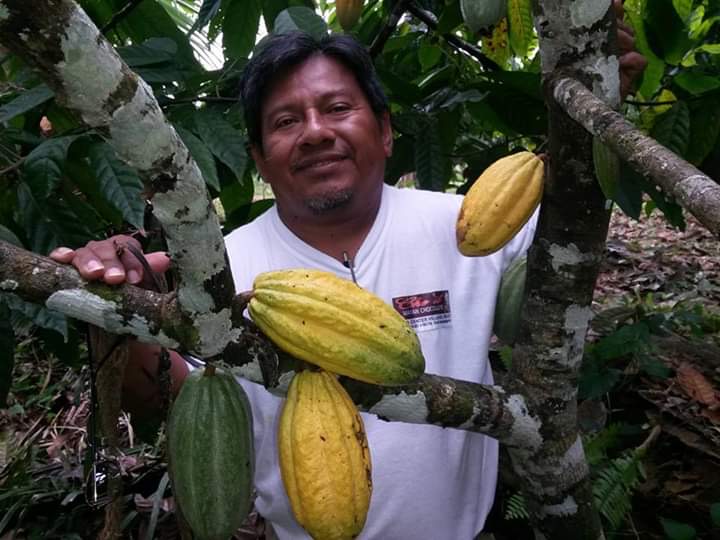
Saqui already works with Yazzie and other Native groups, including the Native American Food Sovereignty Alliance, and he is actively seeking to work with more Indigenous peoples around the world. "For me, they understand the meaning. Chocolate for the Mayan world isn't a treat. It's medicinal. It has a purpose. Other Indigenous people understand that."
Saqui notes that he does do business with entrepreneurs in the U.S., many of whom want the chocolate "dirt cheap." The person who is not Indigenous, says Saqui, "doesn't understand the importance... the difficulty of producing, the health benefit. The Maya people use cacao as medicinal food.” He notes the cacao’s benefits for children, and for improving intestinal issues, diabetes, and its use in reproductive health, and that the Maya people cultivate it without pesticides and chemicals. “These things do not serve commercially, because they have no culture. They only have money."
Yet, says Saqui, in Mayan society, cacao is “one of the most special and spiritual products. It's magical."
Saqui is also navigating the current COVID-19 pandemic and economic crises. "Last year we produced 2,000 bars weekly to supply the hotels and resorts," he says. "Today we are only making 500 bars every two weeks," and the team is down to two staff members.
Despite the crisis, Yazzie’s program –– supported by World Central Kitchen –– continues to purchase cocoa powders that baker Vanessa Casillas (Ho-Chunk, Chicana) whips into a tasty dessert for each meal, like a Belizean chocolate chantilly or cupcakes with Belizean chocolate ganache in the middle, served to a diverse tribal community, including Ojibwe and Dakota elders at the Indian Center.
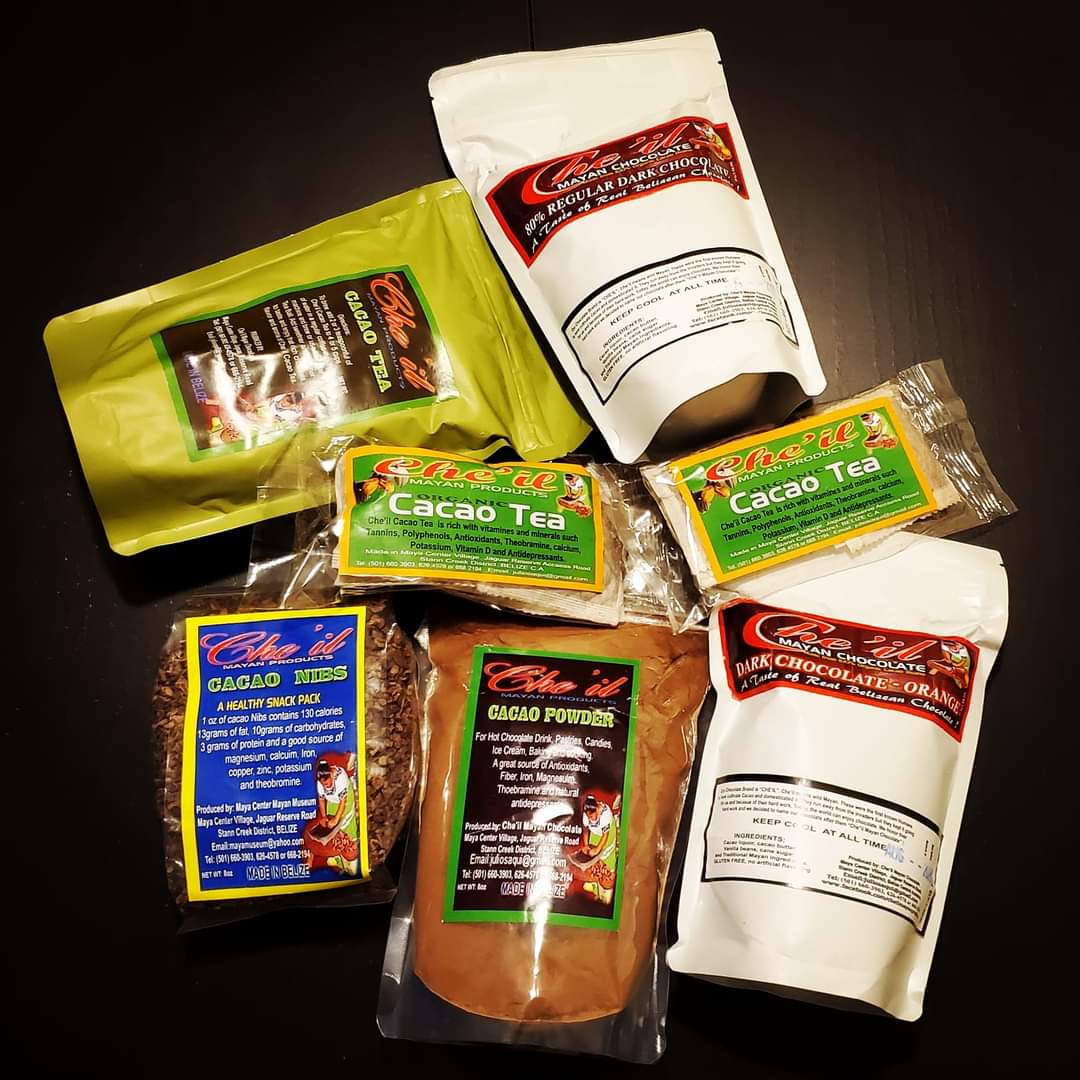 Packaged cacao products from Che’il Mayan Chocolate. (Photo courtesy Brian Yazzie.)Cupcakes aside, the foods and flavors served at the Indian Center go back to “before we had states and borders," says Yazzie. "It's going back to our roots, to the normality of who we were as Indigenous people. I see it as a network frame, connecting with people.” Yazzie’s vision is to see Indigenous markets across the U.S. representing their regional food cultures.
Packaged cacao products from Che’il Mayan Chocolate. (Photo courtesy Brian Yazzie.)Cupcakes aside, the foods and flavors served at the Indian Center go back to “before we had states and borders," says Yazzie. "It's going back to our roots, to the normality of who we were as Indigenous people. I see it as a network frame, connecting with people.” Yazzie’s vision is to see Indigenous markets across the U.S. representing their regional food cultures.
Yazzie does this work around the globe, traveling to Europe and Asia to learn and teach, and sees evidence of global Indigenous connection that continues to be remembered. When he traveled with Slow Food Turtle Island to Sapporo, Japan in 2019, the Ainu people hosted them. One of Yazzies colleagues from the Ohlone Tribe in the Bay Area had brought acorn flour –– and the Ainu people were both astonished and excited. Before the colonization of Japan, before rice paddies took over the landscape, the Ainu had been the Acorn people. Tears were shed, to know North America had acorn, too.
"When you exchange food, you exchange the stories of it, the responsibility of it," Casillas says. "You know each variety like a personality. They all have different characteristics, likes and dislikes, and different nutritional content. You have a relationship. You exchange that knowledge."
That is a big point that is often lost when colonized trade, business, or economics are brought up –– even in the context of food or plant commodities. Yet what has been exchanged in pre-colonial trade since time immemorial is that knowledge. The simple act of being in a relationship with others and with relatives, culture, information, stories, history, spirit –– and more –– is all being exchanged.
It transcends food, and can access deeper ties.
Traditional healing, from Africa to North America to Korea
Mojisola Yäi (Fon, Yoruba) lives in present day Benin, although she spent some of her youth in the United States. In Benin, voodoo is an official religion and it’s the only country in Africa whose government officially recognizes it.
"We're still on our native land," says Yäi. "We still use native plants and medicine. People live to be 100. They have less stress. They know how to heal each other. They are in their own land. They don't have the stress of [paying for] insurance, and live mostly from their land. It's hard for them to see it as an advantage, because we are trained to want the capitalist picture... People don't know what colonization is. It's blinding. Colonization makes you want to be anywhere else but here, and they can't imagine people are suffering in the U.S. because of their way of life."
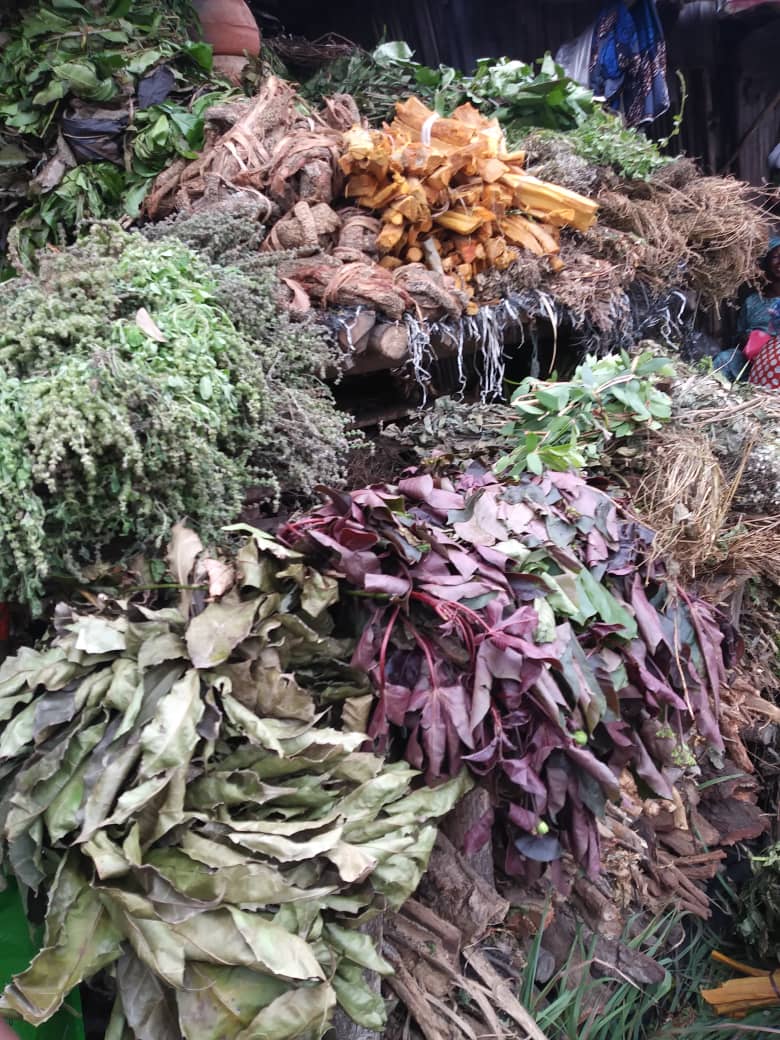
People in the United States, says Yäi, are often not on their native land, and they often don't know how to heal themselves. "They don't know what to use [to heal] besides money. Even if you're paying for insurance, you're not getting good care. You're still suffering," Yäi observes.
Maternal mortality rates in the U.S. for black women are terrible, she points out. African American women die of pregnancy-related complications at three times the rate of white women. For American Indians and Alaskan Natives, the rate is 2.5 times as high. So Yäi works to bring African American midwives from the United States to Benin to learn traditional, lifelong ways of womb care and herbs.
Divine Bailey-Nicholas, of Opelousas, La., is an African American student midwife and herbalist. She has traced her family roots back to parts of West Africa, where her ancestors were stolen from. In 2019, she traveled to Benin to study with Yaï, where she was struck by similarities between the places: both were colonized by the French. Even more moving to her was the connection through the plants. Yaï’s aunt was explaining in her native Fon how clove is used as medicine after childbirth –– the same way Bailey-Nicholas had learned to use it in the U.S. South. Bailey-Nicholas immediately recognized what was happening, even though she doesn’t speak Fon.
“When I saw that connection, I wanted to cry,” says Bailey-Nichols. “The connection has not been lost... We still remember.”
“The same way that folks Indigenous to this land” have lost some tradition, Bailey-Nicholas observes, “There’s things lost in Black folk tradition.” But the connection, she says, is still there, as one family might remember how to use okra medicinally, another family will remember another plant, and they can teach the families who don’t remember.
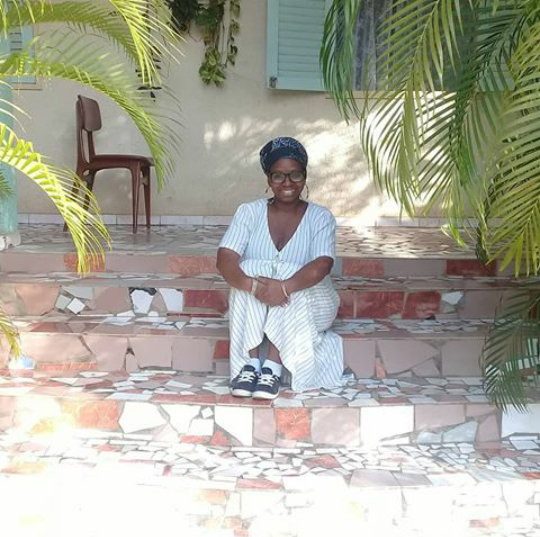 Divine Bailey-Nicholas during her trip to Benin. (Photo courtesy Divine Bailey-Nicholas.) That remembrance travels beyond borders, perceived race, and culture. Yäi also studies with Panquetzani, a healer and teacher from Coahuilteca and Mexica traditions who teaches traditional healing and works with Indigenous peoples and other Indigenous healers from around the world. For Panquetzani, teaching and connecting through the sharing of traditional medicines can bring into memory old commonalities. For example, while working with a Korean traditional medicine practitioner, she learned the value of mugwort in their creation story. The plant similarly shows up in her own origin story, too, and is used similarly in Panquetzani’s lineage. Uncovering these kinds of understandings is “validating,” says Panquetzani, “and propels work forward.”
Divine Bailey-Nicholas during her trip to Benin. (Photo courtesy Divine Bailey-Nicholas.) That remembrance travels beyond borders, perceived race, and culture. Yäi also studies with Panquetzani, a healer and teacher from Coahuilteca and Mexica traditions who teaches traditional healing and works with Indigenous peoples and other Indigenous healers from around the world. For Panquetzani, teaching and connecting through the sharing of traditional medicines can bring into memory old commonalities. For example, while working with a Korean traditional medicine practitioner, she learned the value of mugwort in their creation story. The plant similarly shows up in her own origin story, too, and is used similarly in Panquetzani’s lineage. Uncovering these kinds of understandings is “validating,” says Panquetzani, “and propels work forward.”
For Yäi in Benin, it’s the same feeling working with Panquetzani: some of the traditional ways are similar, such as how to measure ingredients. "We are tied. Our freedoms are tied. Our food is tied,” Yäi says, noting the importance of and connection to corn now, in Africa. It becomes clear we were all connected before, as more of these connections are remembered and cultivated today.
Revitalizing those networks and building sovereign space for them, is coming.
Sovereign ports
Nicole Yanes (Opata) in Sonora and Arizona, lives in the Borderlands of Nogales on the present-day U.S.-Mexico border. She works as a program officer with the NDN Collective, whose mission is to “build the collective power of Indigenous Peoples, communities, and Nations to exercise our inherent right to self-determination, while fostering a world that is built on a foundation of justice and equity for all people and the planet.” She is also the food sovereignty program consultant for the International Indian Treaty Council, and works with the Native American Food Sovereignty Alliance.
“Traditionally, within our territory, there's respective boundaries within our tribal nations. There's common grounds, where we could harvest,” Yanes says. But the border lines crossed the land, both to the South and the North. “Those have been a huge detriment to our culture.”

Historically, these border lines have cut cultural ties and have prevented trade from continuing, and they continue to be a detriment to exchange. They are prohibitively expensive to trade through, or be detained in. They separate people, notes Yanes, and create a huge challenge for people who seek to reconnect.
"How is it that we as Indigenous communities are not able to trade and have free passage?" asks Neftalí Durán (Mixteco), a community cook with the I-Collective, a group highlighting historical and contemporary Indigenous “resilience and innovations in gastronomy, agriculture, the arts, and society.”
The United Nations Declaration on the Rights of Indigenous Peoples, Article 36, states:
- Indigenous peoples, in particular those divided by international borders, have the right to maintain and develop contacts, relations and cooperation, including activities for spiritual, cultural, political, economic and social purposes, with their own members as well as other peoples across borders.
- States, in consultation and cooperation with indigenous peoples, shall take effective measures to facilitate the exercise and ensure the implementation of this right.
“This Article doesn’t mean anything if we as tribal nations don't exercise it,” says Yanes.
“Why are we paying the U.S. government to bring [Indigenous products] in?” she asks. “Why can't we go through tribal nations, and pay them the tax fee we would pay the U.S. government?”
Yanes advocates for using the “inherent rights we have as Indigenous people to restore our trade routes, recognizing that we are sovereign nations that can make agreements with other nations.”
A place to start this might be by creating a sovereign port with a tribal nation the border runs through now, she says, adding that agreements can be made with nations that have been here for thousands of years.
“It’s not only exercising our self-determination,” says Yanes. "It’s building our sovereign nations, and it’s building our economies.” She adds: “It’s up to us at the local and tribal level. It’s up to us to implement our rights, based on our inherent right to trade, to exchange food and medicines and seeds and goods.”
For Yanes, this vision includes setting up present-day reservations as sovereign ports –– such as reservations or reserves or other traditional lands where the borders crossed –– to be able to bring in and enter trade agreements with other Indigenous groups. “It’s a process,” says Yanes. “You don’t make a treaty in a day or a week. It's about building those relationships, talking through those agreements. It's about interconnectedness. And also a way to dismantle the concept of colonial borders.”
Cultivating the future
The idea of sovereign ports is rooted in Indigenous connectivity around the world –– a connectivity that flourished in pre-colonial times that can be cultivated and strengthened again today. After all, pre-colonization, Native groups were trading and entering into their own agreements, methods and places of exchange. In that regard, sovereign ports aren't so much a new idea as they are the revitalization of what existed prior to colonization.
More reconnections, through pre-colonial food such as what Yazzie’s team prepares at the Indian Center, and exchange through food, plants, and knowledge, from Yoruba to Mexica, Maya to Navajo, is a reconnection that can be protected, cultivated, healed and supported in the years to come, whether through sovereign ports, or through travel or in our own kitchens and communities.
Whatever the form, the reconnection through ancestral exchange is healing work, Durán says. “We all carry this knowledge and amazing gifts, especially when we are facing climate change and massive migration.”
Yäi sees a future in connecting more Native Africans and Native Americans together, to share knowledge, to share respect, to acknowledge what's happened through colonization, and to acknowledge and trade Native healing modalities, and to figure out ways to move forward, together.
Africa, says Yäi, is often portrayed as needing the help of the colonized world –– Native America is often painted this way, too. Native leaders on both continents see how much abundance there really is, especially in our shared connections to the land and the knowledge we have. As in Indian Country, “We're still here, growing our food, living on the land," says Yäi.
Yanes notes how fragile the colonized food and economic systems are around the world, especially as witnessed during the COVID-19 outbreaks at meat and food packing plants blanketing the middle of the U.S., and the economic peril caused by having basic life needs structured to be met by outside income.
By building networks within tribes and with other tribes, and cultivating new agreements that support tribal sovereignty and economy, Indigenous people will be set up to support themselves and their communities and to meet all of their needs in a healthy way –– without risking dramatic loss when the colonized systems fail.
This is the opportunity that COVID-19 is presenting Indigenous people around the globe: the opportunity to pivot to more sovereignty, to better relationships, and to a healthier way of life.
And to remember.
Bailey-Nicholas observes this role of history in carrying us forward: “We must go back, to fetch our traditions and bring them forward.” No matter how painful accessing that memory, or returning to our land, might be. That journey, whether to the kitchen, to the land, across the border or across the sea, is one worth taking, as we cultivate new networks of exchange and bolster our sovereignty for a future that remembers our connectivity.
Help us defend tribal sovereignty.
At Native News Online, our mission is rooted in telling the stories that strengthen sovereignty and uplift Indigenous voices — not just at year’s end, but every single day.
Because of your generosity last year, we were able to keep our reporters on the ground in tribal communities, at national gatherings and in the halls of Congress — covering the issues that matter most to Indian Country: sovereignty, culture, education, health and economic opportunity.
That support sustained us through a tough year in 2025. Now, as we look to the year ahead, we need your help right now to ensure warrior journalism remains strong — reporting that defends tribal sovereignty, amplifies Native truth, and holds power accountable.
 The stakes couldn't be higher. Your support keeps Native voices heard, Native stories told and Native sovereignty defended.
The stakes couldn't be higher. Your support keeps Native voices heard, Native stories told and Native sovereignty defended.
Stand with Warrior Journalism today.
Levi Rickert (Potawatomi), Editor & Publisher
